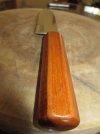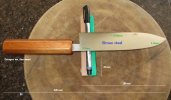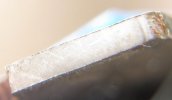BluntCut MetalWorks
Knifemaker / Craftsman / Service Provider
- Joined
- Apr 28, 2012
- Messages
- 3,464
I'm having fun with my backyard knife making. Turned an Elmax bar stock into this petty. Heat treated using a propane torch + charcoal + electric stove top. Used a Koa wood from a thrift store serving tray for a handle.
It took a long time to grind the blade into shape after HT. I was aimed for a laser distal but reality of grinding hard alloy stopped it here.
I'll performance test this prototype along side with a Yoshikane 180mm skd-11 64rc petty.
Quick stats
OAL: 320mm
Blade length from heel: 185mm
Steel: Elmax
Handle: koa, octagon wa
HT: backyard, estimated 60rc (w/o subzero nor cryo quench)
Height: 37mm
Balance: 15mm from heel
Thickness: heel: 2.5mm; 1cm from tip; 1.2mm; 5mm behind-the-edge: 0.56mm


What's your frank/blunt opinions?
Thanks
It took a long time to grind the blade into shape after HT. I was aimed for a laser distal but reality of grinding hard alloy stopped it here.
I'll performance test this prototype along side with a Yoshikane 180mm skd-11 64rc petty.
Quick stats
OAL: 320mm
Blade length from heel: 185mm
Steel: Elmax
Handle: koa, octagon wa
HT: backyard, estimated 60rc (w/o subzero nor cryo quench)
Height: 37mm
Balance: 15mm from heel
Thickness: heel: 2.5mm; 1cm from tip; 1.2mm; 5mm behind-the-edge: 0.56mm


What's your frank/blunt opinions?
Thanks
Last edited:

